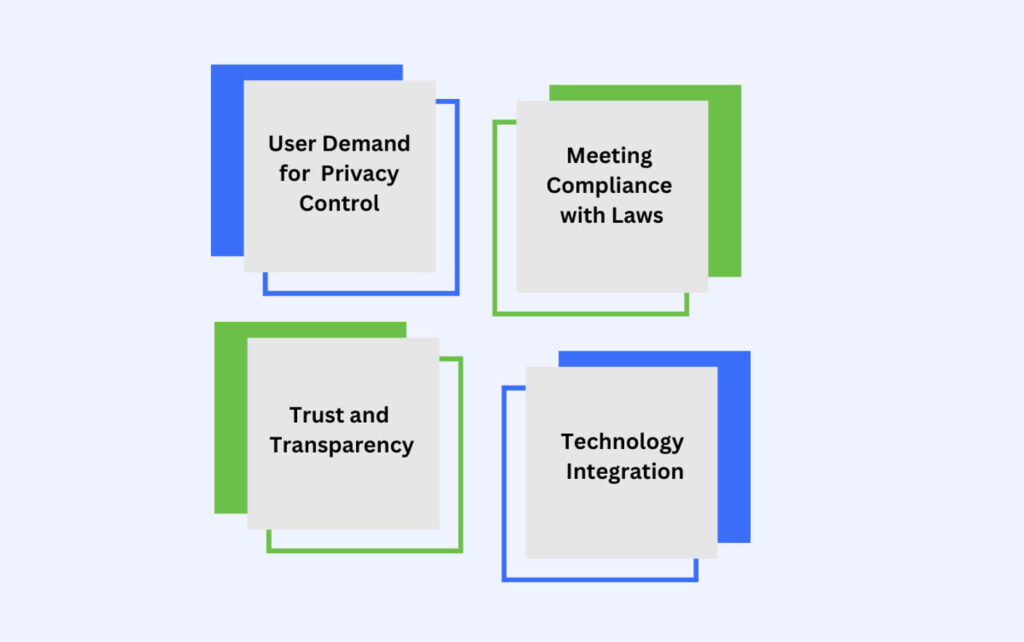Do you want to know what the world will suffer without Global Privacy Control? Remember Automation Personnel Services.
This company is still reeling from the blow given to them by the 2020 data breach. After having settled with the company on December 24, 2024, to the astounding sum of $1.375 million, the company lost both money and reputation.
This latest outcome reinforces just how lasting the devastation of information security breaches can be. The breach has already cost the company millions and is economically degrading. It is more proof that privacy breaches are seldom short-lived, and without GPC and this class of approaches, public information remains vulnerable.
With Global Privacy Controls, we can think of a future where privacy is not a privilege but a right. In that, GPC promises an understandable and powerful signal whereby users have a claim over their data, a stepping-stone towards a future that honours individual privacy more personally.
In this detailed blog, we’ll guide you through what GPC is, how it works, and the benefits it offers to your business.
Global Privacy Control is more than just a technical mechanism – it’s a fundamental right in the digital age. At its core, GPC is a universal privacy signal that allows users to communicate their desire to opt-out of the sale and sharing of their personal information across multiple websites and platforms simultaneously.
As data breaches, targeted advertising, and invasive tracking become increasingly prevalent, consumers are demanding more control over their personal information. The global privacy control movement is a direct response to these growing concerns, providing individuals with a robust mechanism to protect their digital identities.
The genesis of Global Privacy Control can be traced to a collaborative effort among privacy advocates, technology experts, and legal professionals who recognised the growing need for a standardised privacy protection mechanism. Born from the frustration of ineffective existing tools like Do-Not-Track, GPC represents a more robust and legally recognised approach to digital privacy.
Key Stakeholders and Organisations Behind GPC
A diverse coalition of organisations has been instrumental in developing and promoting Global Privacy Control:
These stakeholders have worked tirelessly to create a universal mechanism that transcends individual platform limitations and provides real, meaningful privacy protection.
Think of GPC as a digital “Do Not Disturb” sign for your personal data.
Technical Breakdown of GPC Signals
Global Privacy Control operates through a sophisticated yet elegant mechanism. When enabled, it sends a clear, machine-readable signal to websites via an HTTP header. This signal communicates the user’s explicit preference to:
How Websites Detect and Process GPC Requests
Compliant websites must implement specialised server-side logic to:
Global Privacy Control (GPC) helps users automatically tell websites not to sell or share their data.
While similar in concept, Global Privacy Control distinguishes itself through:
Traditional Consent Management Platforms often rely on intrusive cookie banners and complex opt-in/opt-out processes. Global Privacy Control revolutionises this approach by:
Unlike the largely ignored Do-Not-Track mechanism, Global Privacy Control offers:
For businesses, Global Privacy Control represents both a challenge and an opportunity:
Challenges:
Opportunities:
GPC plays a key role in both U.S. and international data privacy regulations, shaping how businesses handle user data.
| Data Privacy Law | GPC Obligations | Enforcement Date |
|---|---|---|
| California Consumer Privacy Act (CCPA) | Businesses with websites must honor GPCs as a method allowing users to opt out of selling or sharing personal data | Currently in Force |
| Colorado Privacy Act (CPA) | The Colorado Attorney General provided technical requirements for universal opt-out mechanisms | July 1, 2024 |
| Connecticut Data Privacy Act (CTDPA) | Controllers must honor universal opt-out mechanisms | January 1, 2025 |
| Delaware Personal Data Privacy Act (DPDPA) | Protected users can designate privacy choices via browser settings, extensions, or global device settings | January 1, 2026 |
| Montana Consumer Data Privacy Act (MCDPA) | Businesses must recognise and respect global device settings indicating opt-out preferences | January 1, 2025 |
| Oregon Consumer Privacy Act (OCPA) | Covered entities must recognise browser extensions and global privacy device settings | January 1, 2026 |
| Texas Data Privacy and Security Act (TDPSA) | Covered entities must honor consumer universal opt-out mechanisms | January 1, 2025 |
International adoption continues to expand:
| Jurisdiction | Global Privacy Control Considerations |
|---|---|
| European Union (GDPR) | While not directly mandated, it aligns with GDPR's principles of user consent and data minimisation |
| Brazil (LGPD) | Supports user rights to control personal data processing |
| South Africa (POPIA) | Consistent with data subject rights and consent requirements |
| Transparency Consent Framework (TCF) 2.2 | Provides a complementary mechanism for user privacy preferences |
Implementing GPC ensures businesses respect user privacy preferences and stay compliant with evolving regulations.
The implementation process involves several critical stages:
Before diving into implementation, conduct a thorough audit of your current data handling practices. This means:
Consider this phase as a digital privacy health check. You’re not just looking for compliance – you’re redesigning your approach to user data with respect and transparency at the core.
The heart of Global Privacy Control lies in its ability to communicate user preferences instantly. Your technical team must develop robust mechanisms to:
This isn’t just about adding a few lines of code – it’s about fundamentally reimagining your data interaction framework.
Implementation goes beyond technical configuration. It requires:
Most businesses encounter similar challenges when implementing Global Privacy Control:
The key is a phased, methodical approach that prioritises user trust and regulatory compliance.
For individual users, enabling Global Privacy Control is about reclaiming digital autonomy. It’s more than just flipping a switch – it’s about understanding and exercising your privacy rights.
Not all browsers and privacy tools are created equal. Users must carefully select:

With the effective incorporation of GPC, businesses can comply with emerging privacy laws and develop healthier relationships with their users, appearing credible by showing their commitment to protecting data and respecting users’ privacy choices.
Consider the case of GPC integration and its effects in the e-commerce and media sectors, sectors for which consumer trust is a prime driver for business.
Major companies like Pinterest and Salesforce have incorporated GPC signals into their platforms, allowing users to exercise a universal right to opt out of data sharing.
Hence, a rise in user engagement, most notably from users who feel confident about their online interactions.
In the media industry, publishers who have adopted GPC noted a decline in interactions with banners seeking consent, which typically means users are happy with the more straightforward, clearer controls over their privacy.
For instance, GPC is introduced on The New York Times and The Washington Post websites, resulting in increased user trust in these media outlets as they demonstrate a visible commitment to user data rights.
At Seers.ai, we understand that privacy is not a one-size-fits-all solution. Our advanced platform goes beyond simple signal detection, offering a comprehensive approach to honoring Global Privacy Control (GPC) signals that adapts to the unique needs of your digital ecosystem.
Our cutting-edge technology provides:
We recognise that different jurisdictions have unique privacy requirements. Seers.ai offers:
Empower your users with our intuitive privacy management tools:
Our platform is designed to work effortlessly with your existing digital infrastructure:
A combination of relevant factors is responsible for the rising adoption of GPC.

As data privacy concerns rise, users are increasingly seeking tools that render them better control over their online data. GPC provides a straightforward, technical way for users to enforce their privacy preferences across a range of websites; hence it’s one of the reasons it’s being adopted on a wide scale.
As privacy laws evolve and become more stringent, businesses are seeking effective solutions to ensure compliance. GPC provides an efficient way for companies to get compliance with the opt-out requirements of both GDPR and CCPA guidelines supported by reducing the complexity of managing individual consent banners and notices for each visitor.
Consumers tend to trust companies that respect their privacy choices. By supporting GPC, companies show a commitment to user privacy, fostering trust and building long-term relationships with customers.
As increasing support surfaces from major browsers like Firefox, Brave, and DuckDuckGo together with browser extensions for others like Google Chrome, GPC adoption has gained traction. Its technical integration into greatly used web tools allows for a more elegant choice for the privacy-conscious user.
With general and differing regulations and directives in mind, GPC is good for what will clarify and streamline users’ rights and reduce the perpetual burden of different consents for different jurisdictions.
Support for GPC will come from regulatory authorities, the commercial sector, and browsers. This broad backing increases its potential to become a de facto standard for online privacy and personal data protection.
The digital privacy landscape is rapidly evolving, with the Global Privacy Control (GPC) emerging as a promising solution to complex data protection challenges. As consumers become more aware of their digital footprint, the GPC offers a universal opt-out mechanism that could simplify consent processes across websites and platforms.
While not yet universally adopted, the GPC represents a significant step towards standardising privacy controls. The initiative addresses growing user fatigue with endless consent choices, providing a potential “set it and forget it” approach to online privacy.
However, challenges remain, particularly around meeting strict legal requirements for informed consent. As technology advances, the GPC is likely to become more sophisticated, offering more robust and user-friendly privacy protection tools.
Global Privacy Control represents more than a technical solution—it’s our way of giving people back control of their digital lives. By empowering individuals to manage their personal data, we’re creating a more transparent online ecosystem where users understand and decide how their information is used.
At Seers.ai, we’re not just providing a service; we’re leading a movement. Our advanced privacy solutions transform data protection from a compliance challenge into a strategic opportunity, helping businesses build genuine trust while respecting individual rights in an increasingly complex digital world.
 Rimsha Zafar
Rimsha ZafarRimsha is a Senior Content Writer at Seers AI with over 5 years of experience in advanced technologies and AI-driven tools. Her expertise as a research analyst shapes clear, thoughtful insights into responsible data use, trust, and future-facing technologies.
United Kingdom
24 Holborn Viaduct
London, EC1A 2BN

Seers Group © 2025 All Rights Reserved
Terms of use | Privacy policy | Cookie Policy | Sitemap | Do Not Sell or Share My Personal Information.
Seers AI Referral Program
Refer Seers AI, give 15% off to new users, & earn 15% commission on every signup!
